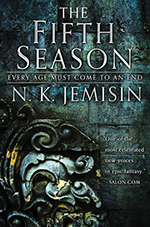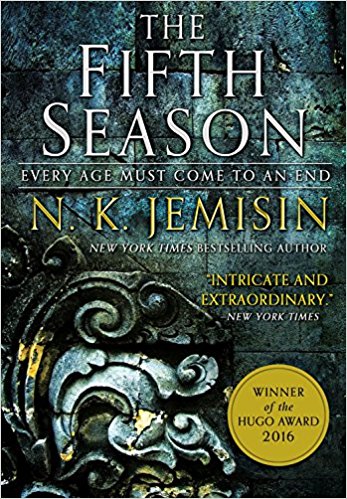 After reading Mika McKinnon‘s endorsement of this series on Twitter (example), I downloaded an audiobook copy of N.K. Jemisin’s first book in her “Broken Earth” trilogy, The Fifth Season. It is a fantasy novel with a healthy seasoning (ha! no pun intended) of science fiction. The story is set in a world called “Earth,” but it’s not clear if it’s the same world as our own, in the distant past or the distant future. The people that inhabit the “Earth” of the novel are both quite familiar as humans, yet some have the ability to manifest tectonic changes in their planet. When an earthquake is about to strike, for instance, these gifted people can use their powers to sense it coming, and stop it. This takes a lot of effort, and as they draw energy from their surroundings for the task, a frozen zone manifests itself around them as they work. These “orogenes” can also break the Earth – triggering earthquakes or volcanic eruptions. Because of their power, they are feared by other humans, who seek to control them. Much of the novel’s dramatic arc is driven by the relationship between the orogenes and their “still” controllers. The training of the orogenes, their professional work, their coping with the social stigma of their talents – those are all part of the tapestry of the book. There are some odd extras that I don’t really understand: “stone eaters” which appear to be living rock sort-of-people, and strange obelisks which move through the Earth’s interior. But presumably their existence and purpose will be made clear in the latter two books of the trilogy. The Fifth Season is a fully realized imagined world, and its description and details are rich. It is worth reading for the ratio of strange and familiar it conjures. Because the version of “Earth” in this “Broken Earth” series has fundamental differences from our own world, there’s a lot of new vocabulary to master. Sometimes multiple words refer to the same thing, as how you eventually come to realize that “ragga” is a slur for “orogene.” Sometimes it’s plain that new terms are stand-ins for words in our own argot. (For instance, when orogenes curse, they yell something like “Blech! This rusting soup tastes awful!” – where “rust” has attained a new kind of “four-letter” status.) These new words can be both enticing to the geoscientist reader and also off-putting in their multitudes (at least initially). I found the book hard to get into for the first few chapters, but once I’d mastered the lingo and dipped into each of the three separate strands of the story twice apiece, I got into it properly. I would prepare readers minimally for the “Broken Earth” they are about to enter, so they can discover its strange wonders on their own, but I would emphasize to prepare themselves for three stories in one novel, one of which is told in the second-person perspective. It takes time to wrap your mind around all that, but I found that the payoff was worth it. The three are connected in ways that aren’t at first apparent, and it’s a refreshing bonus that all three feature strong women of color as main characters. I’ll be headed soon for the next book in the trilogy. If my endorsement isn’t enough, know that this novel won the 2016 Hugo award for science fiction. It’s something unique in my experience.
After reading Mika McKinnon‘s endorsement of this series on Twitter (example), I downloaded an audiobook copy of N.K. Jemisin’s first book in her “Broken Earth” trilogy, The Fifth Season. It is a fantasy novel with a healthy seasoning (ha! no pun intended) of science fiction. The story is set in a world called “Earth,” but it’s not clear if it’s the same world as our own, in the distant past or the distant future. The people that inhabit the “Earth” of the novel are both quite familiar as humans, yet some have the ability to manifest tectonic changes in their planet. When an earthquake is about to strike, for instance, these gifted people can use their powers to sense it coming, and stop it. This takes a lot of effort, and as they draw energy from their surroundings for the task, a frozen zone manifests itself around them as they work. These “orogenes” can also break the Earth – triggering earthquakes or volcanic eruptions. Because of their power, they are feared by other humans, who seek to control them. Much of the novel’s dramatic arc is driven by the relationship between the orogenes and their “still” controllers. The training of the orogenes, their professional work, their coping with the social stigma of their talents – those are all part of the tapestry of the book. There are some odd extras that I don’t really understand: “stone eaters” which appear to be living rock sort-of-people, and strange obelisks which move through the Earth’s interior. But presumably their existence and purpose will be made clear in the latter two books of the trilogy. The Fifth Season is a fully realized imagined world, and its description and details are rich. It is worth reading for the ratio of strange and familiar it conjures. Because the version of “Earth” in this “Broken Earth” series has fundamental differences from our own world, there’s a lot of new vocabulary to master. Sometimes multiple words refer to the same thing, as how you eventually come to realize that “ragga” is a slur for “orogene.” Sometimes it’s plain that new terms are stand-ins for words in our own argot. (For instance, when orogenes curse, they yell something like “Blech! This rusting soup tastes awful!” – where “rust” has attained a new kind of “four-letter” status.) These new words can be both enticing to the geoscientist reader and also off-putting in their multitudes (at least initially). I found the book hard to get into for the first few chapters, but once I’d mastered the lingo and dipped into each of the three separate strands of the story twice apiece, I got into it properly. I would prepare readers minimally for the “Broken Earth” they are about to enter, so they can discover its strange wonders on their own, but I would emphasize to prepare themselves for three stories in one novel, one of which is told in the second-person perspective. It takes time to wrap your mind around all that, but I found that the payoff was worth it. The three are connected in ways that aren’t at first apparent, and it’s a refreshing bonus that all three feature strong women of color as main characters. I’ll be headed soon for the next book in the trilogy. If my endorsement isn’t enough, know that this novel won the 2016 Hugo award for science fiction. It’s something unique in my experience.

